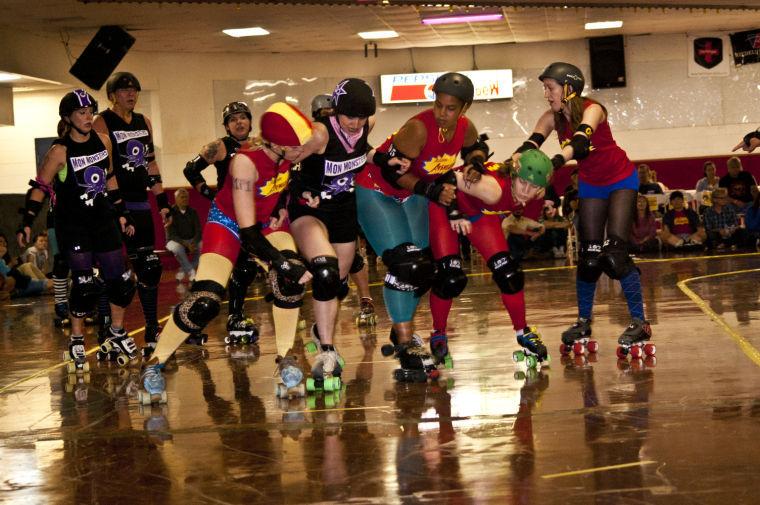Pittsburgh’s Roller Derby teams provides aggressive outlet for the women who play
December 8, 2013
For the women who play it, roller derby is a rare sort of outlet: a female-only full-contact sport in which strength and aggression are virtues.
Although roller derby has been around in various forms since the early 20th century, the modern version is a fast-paced, hard-hitting game of passing and blocking. The sport began in Austin, Texas, in the early 2000s, and after the Austin league was featured in a 2006 reality TV show called Rollergirls, leagues cropped up in cities all across the country.
Steel City Roller Derby, Pittsburgh’s league, formed in 2006 and is presently ranked 19th out of 166 teams by the Women’s Flat Track Derby Association.
Shyloh Hadley, a competitor presently on break from the sport because she is pregnant, said that a big part of the sport’s appeal is being able to participate in a highly competitive women’s sports league.
“Our league is completely owned and operated by skaters, so it’s really nice that we’re able to have a completely women-only environment that’s just focused on us and our development,” Hadley said.
The season opener took place Sunday, Oct. 13, at Romp n’ Roll, a public roller rink in Glenshaw. The arena — complete with greasy concession food, flashing lights, a PA system and the unmistakable smell of rental skates — would be familiar to any child of the ‘80s or ‘90s who went to skating parties.
Two men with microphones served as announcers, and girls, many of whom are the children of the players, hung around the rink until they were called up to sing the National Anthem or to play a mini game between regular games. The crowd sat in folding chairs on the long ends of the roller rink, cheering on the players, many of whom were family or friends.
The Game
Roller girls scrum like rugby players and check like hockey players, but the premise of the game — gaining points by skating past opponents — is unique. Two teams, each with five players, compete on an oval-shaped track. A game has two 30-minute periods, and each period consists of a series of “jams,” which can last up to two minutes.
In the jam, one player on each team is designated the “jammer” and is marked as such by a star on her helmet. The jammer’s job is simple, but tough: escape from the pack, skate past all opposing blockers and make as many laps around the rink as possible.
“Being a jammer is like being a running back and being the ball at the same time,” said Emily Engelhardt, who goes by the track name Hot Lips Bruise’ihan.
Engelhardt, a jammer for the Penn Bruisers, said that in addition to having great endurance, jammers must be able to anticipate and evaluate weaknesses in the opposing team’s defense and communicate with teammates.
“There’s no right way to get through the pack,” said Engelhardt, who sees advantages for both small and large jammers. “One of the very cool things about derby that’s different from a lot of sports I’ve played is that there is a place for everyone no matter what their body type.”
Four opposing blockers try to stop the jammer and include women such as Stephanie Kessler, better known as Vicious Virus.
“I love hitting people,” said Kessler, the Mon Monsters’ team captain. Blockers can hit opposing players with any body part from shoulder-level to hip-level, except for their arms. They prevent the jammer from scoring by knocking her out of bounds or by keeping her from moving forward.
“I think there’s more strategy involved in blocking because you have to be aware of everything that’s going on around you,” said Kessler, who described one move called “eat the baby.” This strategy takes advantage of league rules by having the blocker who knocked out the jammer skate backward, or clockwise around the rink,pushing the jammer back into the pack and thus making it tougher for her to get back in the game.
“[For eat the baby], you’re knocking that jammer out,” said Kessler, “then you’re pulling her the whole way back into the pack, so she has to fight through everybody all over again.”
Both teams play offense and defense simultaneously. The jammers compete to beat one another out of the pack, and the one who makes it out first becomes the “lead jammer” — the only person on the track able to score points. She scores a point for each of the opposing players she passes on subsequent laps, with some jammers scoring 20 or more points on a single jam. The jam ends either after two minutes or after the lead jammer ends the jam by making a hand signal to the referees.
Steel City
Contemporary women’s roller derby leagues get their rules from the Women’s Flat Track Derby Association, which formed in 2004.
When Steel City Roller Derby was formed in 2006, there were 70 players, and the league has attracted new players every year since. Presently there are 68 league members.
“There were no teams for the first year,” said Pam Ellis, one of the founding members of Steel City Roller Derby and its public relations director. “We started out with everybody learning how to skate and no jam until March of 2007.”
Now, the Steel City has three home teams and two travel teams that compete with other leagues in the association. This year’s league play began Oct. 13, with the reigning champion Mon Monsters beating both the Allegheny Avengers and Penn Bruisers. In January, many of the best players from these teams will compete as Steel Hurtin’, Steel City Roller Derby’s “A-team,” according to Ellis, and the Steel Beamers, which she likens to junior varsity.
Jessica Kent, better known as the Kraken, is on Steel Hurtin’. Kent is in her third season of derby and is a blocker for the Allegheny Avengers. She’s been skating since she was 5 years old.
“I’ve kind of been a rink rat all my life,” said Kent, who said that she used to work at Romp n’ Roll and got to know the man who would later become her fiance through their common love of roller skating. As a member of Steel Hurtin’, Kent is required to train twice a week with a personal trainer in addition to the weekly on-rink training.
“When I went [to the trainer], I couldn’t get through a workout,” she said. “Now I’m deadlifting a hundred pounds.”
For Kent, roller derby has been life-changing.
“I used to be a really shy person,” she said. “It’s made me be a lot more social. I love to talk to people and to talk about derby.”








